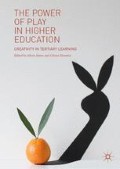Abstract
This case study describes playful object-oriented pedagogy in professional teacher education. Using a Cabinet of Curiosities theme, the ‘wunderkammer’ or ‘wonder rooms’ of the sixteenth and seventeenth centuries inspired a lesson staged as a wonder room to inspire a creative approach to teacher resource development. Trainee teachers playfully explored, handled and ‘tinkered’ with ‘a sense of wonder’ a curated collection of artefacts and curiosities. The wonder room created an exhilaration and intensification of experience stimulating playful thinking, creativity and reflection. Da Vinci’s principle of ‘curiosità’ (Gelb in How to think like Leonardo da Vinci. Delta, New York, 2009) is explored together with the ‘magical condensation’ associated with play (MacLure in International Journal of Qualitative Studies in Education, 19(6): 729–745, 2006: 737).
Access this chapter
Tax calculation will be finalised at checkout
Purchases are for personal use only
References
Chatterjee, H. (2008). Touch in Museums. Oxford: Berg.
Clover, D., Sanford, K., Bell, L., & Johnson, K. (2016). Adult Education, Museums and Art Galleries: Animating Social, Cultural and Institutional Change. Rotterdam: Sense.
Dewey, J. (1933). How We Think: A Restatement of the Relation of Reflective Thinking. New York: D. C. Heath.
Dillon, B. (2013). Essays at Curiosity. In Curiosity. London: Hayward Publishing.
Frissen, V., Lammes, S., De Lange, M., Mul, J., & Raessens, J. (2015). Playful Identities: The Ludification of Digital Media Cultures. Amsterdam: AU Press.
Gelb, M. (2004). How to Think Like Leonardo da Vinci. New York: Delta.
Huizinga, J. (1938/1970). Homo Ludens: A Study of the Play Element in Culture. London: Maurice Temple Smith Ltd.
Jarvis, J., & Graham, S. (2015). It’s All About the Shoes. York: Higher Education Academy.
Kasworm, C. E., & Bowles, T. A. (2012). Fostering Transformative Learning in Higher Education Settings. In The Handbook of Transformative Learning. San Francisco: Jossey-Bass.
Loi, D., & Dillon, P. (2006). Adaptive Educational Environments as Creative Spaces. Cambridge Journal of Education, 36(3), 363–381.
MacLure, M. (2006). The Bone in the Throat: Some Uncertain Thoughts on Baroque Method. International Journal of Qualitative Studies in Education,19(6), 729–745.
Malbert, R. (2013). Curiosity. London: Hayward Publishing.
Neagu, P. (1969). Palpable Art Manifesto! In Bottinelli, G. (2002). Available at http://www.tate.org.uk/art/artworks/neagu-palpable-object-mosaic.
Norgard, R., Toft-Neilson, C., & Whitton, R. (2016). Playful Teaching Between Freedom and Control. SRHE Conference 2016.
Prown, J. (1982). Mind in Matter: An Introduction to Material Culture Theory and Method. Winterthur Portfolio,17(1), 1–19.
Romanek, D., & Lynch, B. (2008). Touch and the Value of Object Handling. In Touch in Museums: Policy and Practice in Object Handling. Oxford: Berg.
Stafford, B. (2004). Devices of Wonder: From the World in a Box to Images on a Screen. Los Angeles: Getty Research Institute.
Tutchell, S. (2014). Young Children as Artists. Abingdon: Routledge.
Williamson, S. (2017). Pop-Up Art Schools and the ‘Carnivalesque’. In Informal Learning: Perspectives, Challenges and Opportunities. New York: Nova Publishers.
Winnicott, D. (1971). Playing and Reality. London: Tavistock Publications.
Yurtkuran, S., & Taneli, Y. (2013). Medium of Curiosita. Art, Design and Communication in Higher Education, 12(1), 65–90.
Author information
Authors and Affiliations
Corresponding author
Editor information
Editors and Affiliations
Rights and permissions
Copyright information
© 2019 The Author(s)
About this chapter
Cite this chapter
Williamson, S. (2019). Exploration: Cabinets of Curiosities—Playing with Artefacts in Professional Teacher Education. In: James, A., Nerantzi, C. (eds) The Power of Play in Higher Education. Palgrave Macmillan, Cham. https://doi.org/10.1007/978-3-319-95780-7_10
Download citation
DOI: https://doi.org/10.1007/978-3-319-95780-7_10
Published:
Publisher Name: Palgrave Macmillan, Cham
Print ISBN: 978-3-319-95779-1
Online ISBN: 978-3-319-95780-7
eBook Packages: EducationEducation (R0)

